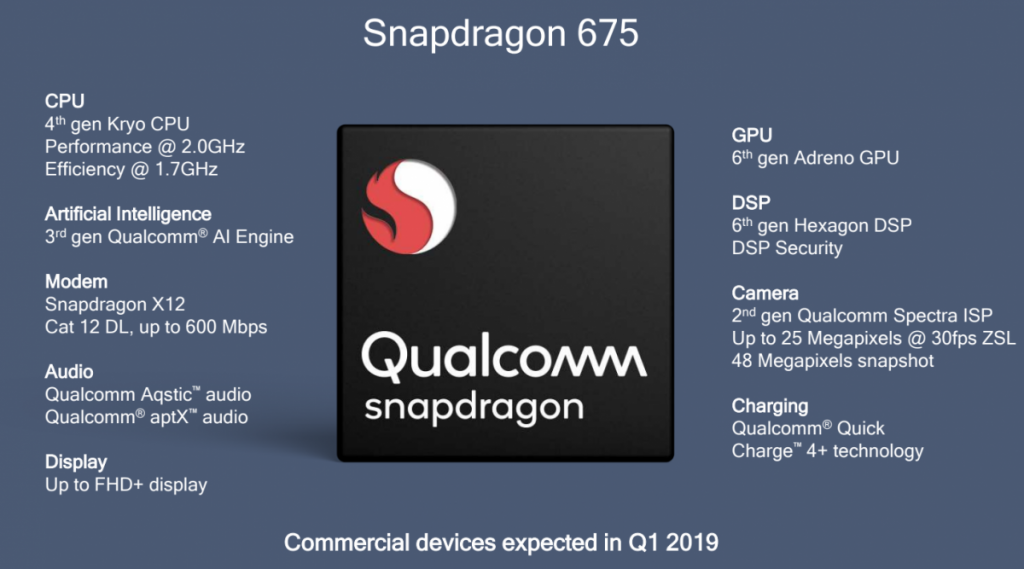For a few years now, we’ve seen affordable phones become competitive options that are able to satisfy the needs of more and more customers. As OEMs shifted their focus towards emergent markets, cost became a premier concern and mid-range components were put into the spotlight. Qualcomm’s 600 series best exemplifies this shift in enthusiast minds, as its chips found their way into over 1,450 designs according to Qualcomm. The company recently announced a few new chips in the family with the Snapdragon 632 and August’s Snapdragon 670. Just a couple of months later, the company is introducing a slight revision to that last chip with the new Snapdragon 675.
Before going into the details, here’s a quick refresher on the recent and current state of the 600 series. The company unveiled the Snapdragon 660 and 630 in May of 2017, and while those chipsets seemingly didn’t earn as many designs as the still-relevant Snapdragon 625/626, they marked an important change of direction for the line-ups. The 660 had brought a set of semi-custom cortex-A73 cores on their performance cluster, built in 14nm LPP process over the previous-gen 28nm HPM which had gotten long in the tooth. These semi-custom Kryo 260 cores could actually perform closer to the premium tier (Snapdragon 835 at the time) than any other mid-range chip had been able to, with the main differences residing in lower CPU frequencies, a smaller L2 cache, and a slower GPU with the Adreno 512. The Snapdragon 630 had also brought 14nm LPP in an A53 octa-core configuration, adding some important features to the mid-end like Bluetooth 5 and LPDDR4 RAM support. We then saw a “successor” to the 660 as the recently-announced Snapdragon 710, while the 632 announced in June is a successor to the Snapdragon 630 in name.
The Snapdragon 660 was a surprisingly performant chipset, so it made sense for Qualcomm to build upon it with the Snapdragon 710 and its give that its own semi-premium discrete category. With the 670, the company brought a healthy speed bump over the 660 while still remaining behind the 710 in both performance and feature capabilities. Now, just a few short months after the 670 was announced, we see yet another number bump with the Snapdragon 675, which brings just a handful of changes.
Snapdragon 675
First things first, the Snapdragon 675 is built on 11nm LPP process technology, which by itself should suggest modest gains over last year’s 14nm LPP fabrication. Surprisingly, though, this is different from the Snapdragon 670’s 10nm LPP fab, an odd turn of events considering the proximity in both name and release date of these two chips. This is also the first chipset in the 600 series to feature the next-generation Kryo 460 CPU. Just like with the 670 and other recent Qualcomm chips, the Kryo 460 of the Snapdragon 675 is a semi-custom core design, delivered in concert with the system architecture while providing some quality of service optimizations. The Built on ARM Cortex license is still quite limiting, but the results should be promising and knowing what these cores are based on should give us a good idea of what to expect as well.
The two Kryo 460 A76-based Gold (performance) cores are clocked up to 2.0GHz, while the six A55-based Silver (efficiency) cores are clocked up to 1.7GHz. Unsurprisingly, these are the same frequencies we saw in the Snapdragon 670 announcement, though the performance cores have seen an architectural refresh. We also find a slightly different cache config, with L1 cache of 64KB and 32KB (Gold/Silver) and L2 cache of 256KB and 64KB (Gold/Silver), as well as a shared 1MB L3 cache as seen on the more powerful Snapdragon chipsets. Qualcomm states that we should expect up to 20% higher performance compared to previous generations. With the Kryo 460, the company claims to see faster performance over the Snapdragon 670’s A75/A55-based CPU package, with a 30% boost to game launching times, a 35% improvement in web-browsing performance, and 15% improve social media launch speeds.
Moving on to graphics, we also see the 600 series receive a latest-gen GPU with the Adreno 612, a step behind the Adreno 615 found in the 675, but superior to the Adreno 512 found in the Snapdragon 660. For comparison, the Adreno 616 of the 710 promised a 35% uplift over that same GPU, so this offering should sit neatly in the middle. As expected, the Snapdragon 670 is capable of powering FHD+ displays, while the 710 offers the ability to scale up to QHD+ for higher-resolution panels (both still support Ultra HD video playback). You’ll also find support for Open GL ES 3.2, Open CL 2.0, as well as Vulkan graphics, and Qualcomm is once again stressing that the GPU can aid AI workloads and heterogeneous compute use-cases. The company also seems to be focusing on gaming performance, unsurprisingly, with the press release reminding us that a number of specific games and game engines are optimized for Snapdragon devices, including Unity, Unreal, Messiah and NeoX. Qualcomm also state that it works closely with both mobile game and game engine developers to improve the gaming UX on Android, though this isn’t unexpected given how they’ve collaborated with game studios such as NetMarble for Snapdragon flagship chip releases in recent years. Ultimately, the company claims that the Snapdragon 675 is “optimized” to run some of the most popular games on Android with 90% fewer janks compared to the same platform, sans the optimizations, as well as “prioritized connectivity” compared to the 670.
Moving onto AI, with the Snapdragon 675 the company is bundling in the powerful Hexagon 685 DSP, found in both the preceding Snapdragon 670, 710, and 845. We’ve had plenty to say about this particular component in the past, but in short, it’ll help with AI workloads by offering great compute capabilities at lower power consumption. All in all, Qualcomm claims that this chipset’s AI Engine (meaning the DSP, GPU, and CPU) can output 1.8x the AI performance of the Snapdragon 660. As usual, you’ll also find support for the Snapdragon Neural Processing SDK, Hexagon NN and Android NN API, and popular ML frameworks such as Caffe/Caffe2, TensorFlow/Lite, and ONNX (Open Neural Network Exchange).
Other important details include the upgraded Spectra 250L ISP (not the regular 250, as featured on the Snapdragon 670), for up to three camera support, with 25MP single camera or 16MP dual camera support. Features include improved stabilization, active depth-sensing, multi-frame (sampling multiple frames for image composition, built into the hardware) noise-reduction and super-resolution, as well as HD slow-motion video capture (480 fps) and 4K video recording (30 fps). And of course, the company is also touting the Spectra 250L's portrait mode capabilities. For connectivity, we have 802.11ac 2×2 Wi-Fi, Bluetooth 5, and the Snapdragon X12 LTE modem for 600Mbps (Cat 15) downlink and 150Mbps (Cat 13) uplink (the Snapdragon 710 features the X20 LTE modem for 1.2Gbps DL). As for memory, expect up to 8GB of LPDDR4x RAM (2×16-bit, up to 1866MHz) on Snapdragon 675 devices. Finally, you’ll also find the expected Aqstic audio codec and aptX audio playback, as well as Quick Charge 4+ for faster charging speeds.
Another Familiar Chip
The Snapdragon 675 continues the trend of mid-tier chipsets seeing premium features make their way downstream, achieving further feature parity with the most powerful mobile platforms in the market. Surprisingly, though, this isn’t a wholly direct upgrade to the chip introduced mere months ago. As you can probably tell from the details above, the Snapdragon 675 has a lot in common with the Snapdragon 670, which in turns means it has a lot in common with the Snapdragon 710, though the upgrade to a newer CPU core is definitely a welcome change. With the recently-announced 632, 439 and 429 chips, the company is now offering a smoother gradient of options for OEMs to choose from, hitting more performance-price ratios that should lead to further-diversified portfolios in today’s competitive market, and in the increasingly fierce mid-range segment in particular. While last time around I had ended the news release stating that Qualcomm’s release strategy had seemingly begun getting a bit clearer, I can’t help but feel confused once more given this sudden bump in the 600-series.
We’ll be keeping an eye on future releases sporting the 675 and, if possible, go hands-on to test just how much of an impact these performance boosts and feature inclusions really make.


